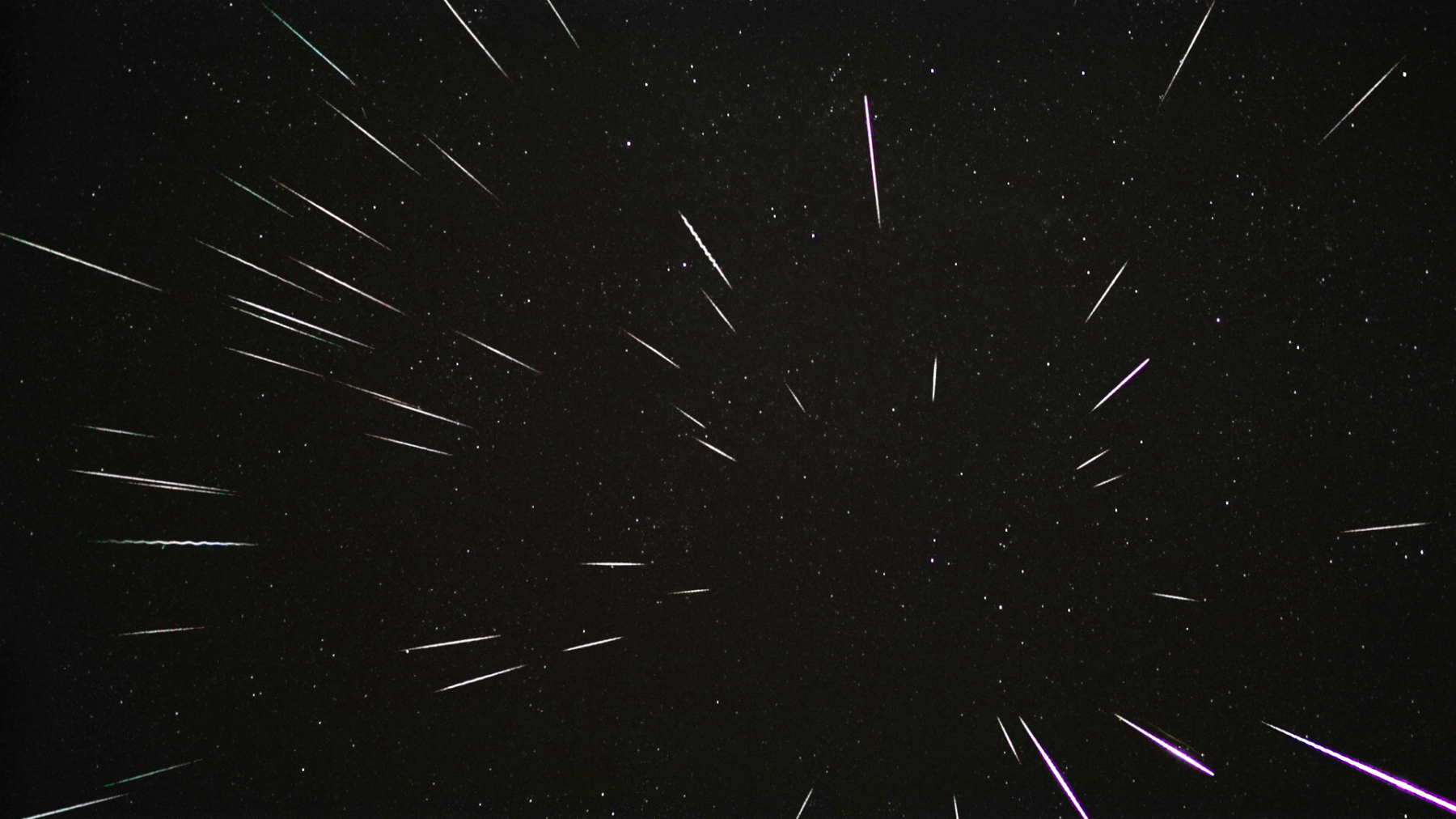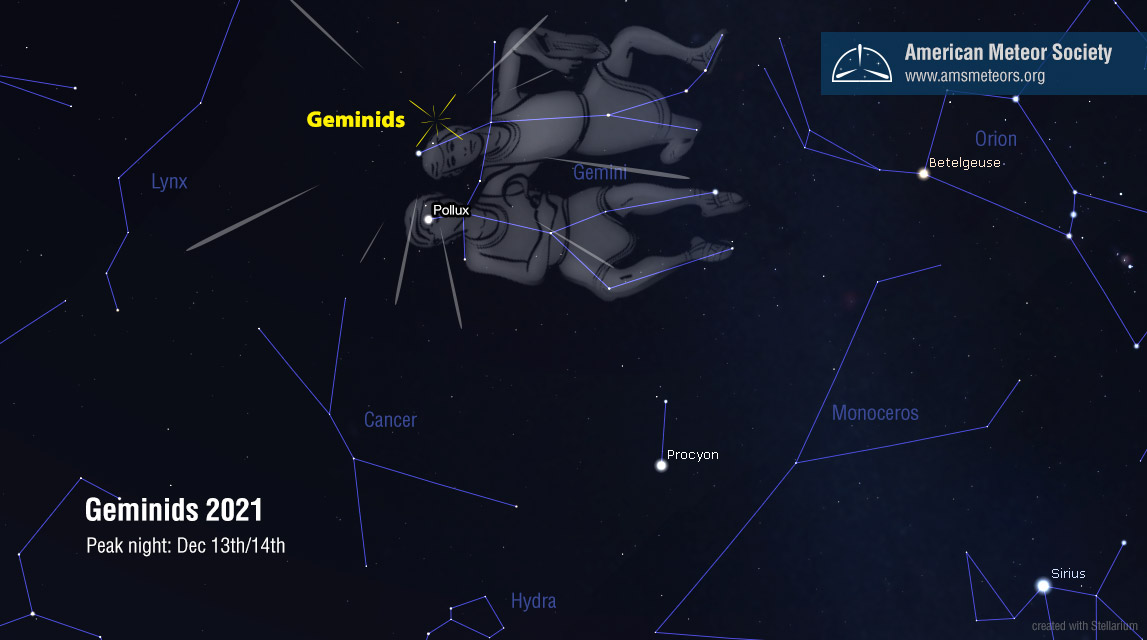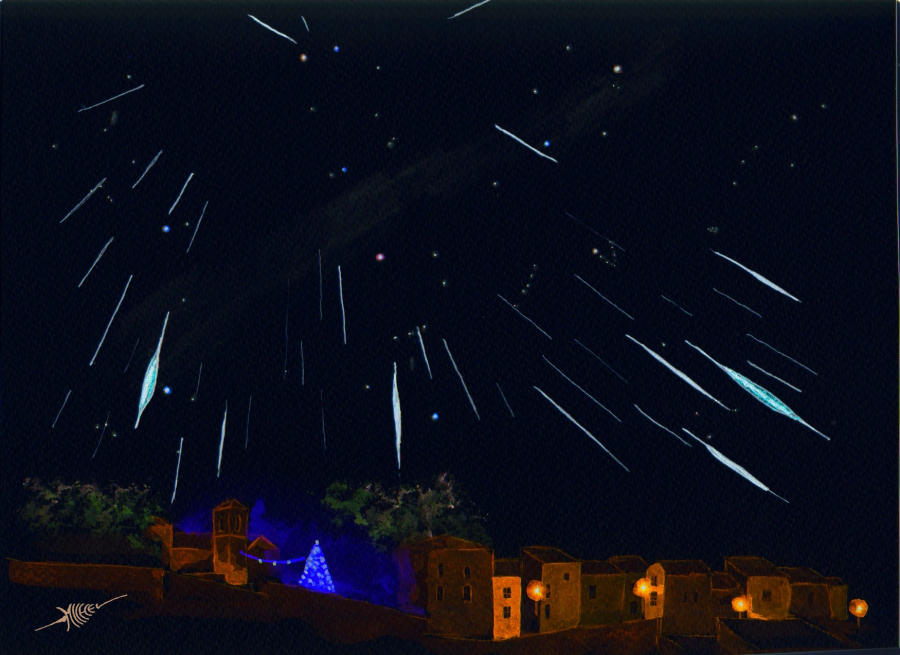
The most dependable meteor shower
Year in and year out the Geminids are currently the most dependable meteor shower. Unfortunately, they are active in December when temperatures are often cold and skies cloudy in the northern hemisphere. Then is this display worth viewing this year? Most certainly, but this year will be compromised with a bright waxing gibbous moon in the sky until 2:00am. Many meteors can still be seen it will be more of a challenge than usual.
The Geminids are often bright and intensely colored. Due to their medium-slow velocity, persistent trains are not usually seen. These meteors are also seen in the southern hemisphere, but only during the middle of the night and at a reduced rate.
Unlike most other meteor showers, the Geminids are not associated with a comet but with an asteroid. 3200 Phaethon is an asteroid with an orbit that brings it closer to the Sun than any other named asteroid (though there are numerous unnamed asteroids with smaller perihelia*). For this reason, it was named after the Greek myth of Phaëthon, son of the sun god Helios. Even though 3200 Phaethon is classified as an asteroid, it often acts like a comet by ejecting dust when it nears the sun. The Earth is near the orbit of 3200 Phaethon during the first three weeks of December. It comes closest to the core of the orbit on December 14th each year. This is the date most Geminid meteors are encountered and seen. When the Earth is near the edge of the orbital debris of the asteroid, little activity is seen.
* The perihelia is the point in a solar orbit where the orbiting body is closest to the sun.
So when and where do I look?
The Geminids are expected to be active between November 19th and December 24th this year. The highest rates are expected to occur on the night of December 13/14, when rates can approach one per minute from dark sky sites. The early portion of the Geminid activity will offer dark skies, but low rates. The Geminids start to kick into high gear about the same time the moon reaches it first quarter phase on December 10th. On this date the moon will be in the sky until midnight, so observations prior to midnight will suffer from interfering moonlight. The light from the half-illuminated first quarter moon is not nearly as severe as that of full moon, so successful observations can be undertaken as long as you face in the opposite direction of the moon. A building or tree can also be used to shield one from the moonlight, but these objects also block a portion of the sky, which will also reduce the number of meteors seen.
If your weather appears to be overcast on the peak night, the two nights prior and the one night after the peak will also produce impressive activity.

The prime hours to watch Geminid activity are between 11pm and 4am local standard time. During these hours the radiant of the Geminid meteors will lie highest above the horizon. This year the moon will still be in the sky, depending on the night you are watching. On the 13/14, the moon will set between 2-3am, allowing dark skies the remainder of the morning. The moon sets roughly an hour later each night so the dates prior to the Geminid maximum will see the moon set earlier in the night. The radiant lies in the constellation of Gemini near the bright star known as Castor (alpha Geminorum). The radiant is not the actual source of the meteors. This artificial point in the sky, as well as the stars of Gemini, happen to lie in the background while the stream of Geminid meteors enter the atmosphere, seemingly from the radiant in the constellation of Gemini. The radiant point and the constellation of Gemini serves as a useful guide to identifying Geminids as not all meteors seen in December are Geminids. There are several other minor showers radiating from the constellations of Orion, Monoceros, Hydra, and Leo Minor, to name a few. There are also random meteors that appear from all over the sky. These meteors once belonged to their own meteor shower, but time has dispersed them to the point that a connection with other meteors is now impossible. On the night of maximum activity, the Geminids will provide over 90 percent of the meteor activity during the night. As you move away from the peak night this percentage falls drastically.
Geminid meteors can appear in any part of the sky. You do not have to face the constellation of Gemini to see them. It does help to have the radiant somewhere within your field of view. This will help in the identification of each meteor. Geminid meteors will shoot outward from the radiant while others will have random paths and speeds. Geminid meteors will appear slowest and shortest near the radiant. This is due to foreshortening as the meteors seen close to the radiant are moving in a direction toward you. Geminid meteors will appear fastest and longest at a point 90 degrees away from the radiant. Beyond 90 degrees distant from the radiant, the meteors will begin to slow and become shorter again.
During the early evening hours, I like to face eastward and watch Geminid earthgrazers shoot from the northeastern horizon. When viewed at this time and position, the Geminid meteoroids (meteors still in outer space) can only graze the upper portions of the atmosphere. Due to the lower density of air molecules at this altitude, the meteors take longer to disintegrate and thus create long streaks in the sky. Most of these long streaks appear low in the north or south, but if you are lucky you will witness some that shoot high overhead.
As the night progresses, the Geminid radiant rises higher into the eastern sky. Their duration and length will become noticeably shorter as they can now penetrate deeper into the atmosphere. This should not cause concern as these meteors still disintegrate while still many miles high in the atmosphere. While the individual meteors may become less impressive, there will now be many more of them as you can now see the meteors that were once shooting downward, below the horizon. For the remainder of the night the Geminids will produce an occasional colorful fireball, which is a meteor brighter than all the objects in the sky except the sun and moon. You may think that fireballs are created by very large meteoroids. Actually, fireballs can be produced by object as small as golf balls. When you consider the average meteor is produced by meteoroids the size of small pebble, then a golf ball is large compared to them. Geminid fireballs are notable for their intense color. Many of these are brilliant green, as well as yellow and orange.
During the peak hours of the Geminid display I will be facing north to avoid the moonlight. As the moon sets I will be shifting my view more westward to keep the radiant within my field of view.
Don’t go outside and stand to try and view the Geminid activity. Your neck will quickly stiffen and you will soon tire. I suggest using a comfortable lounge chair that allows you to look half-way up in the sky comfortably. Bring plenty of blankets to keep warm. Those who wish to contribute meteor counts should watch for at least one hour. The reason for this is that meteoroids are distributed randomly in outer space. When quoted hourly rates are 60, this does not mean you will see one meteor every minute. There will be 5 to 10 minute periods when little activity is evident. There will also be periods of similar length when there will be continuous activity of 3-4 meteors per minute. There are several “peaks” and “valleys” of meteor activity each hour so if you only watch for a short time, you may find yourself viewing during one of the lulls of activity.

Artist and veteran observer Michel Deconinck shares his impressions of the 2020 Geminid meteor shower as seen from Artignosc-sur-Verdon, France. You can see more or Michel’s work at: http://astro.aquarellia.com/ © Michel Deconinck
This year serious observers can help us determine the effect that bright moonlight has upon observers of meteor activity. The International Meteor Organization is conducting a project for observers who view under bright moonlight during the Geminid meteor shower. You simply need to view for at least one hour and estimate your limiting magnitude every 30 minutes. This is easily done by counting the number of stars visible with certain areas of the sky. Charts for these areas are available at: https://www.imo.net/observations/methods/visual-observation/major/observation/#table1. Area 7 on chart #1 would be the easiest to use. Using more than one area is also encouraged to provide more estimates. Of course these limiting magnitude estimates can be attempted at all hours of the night, whether the moon is visible or not. You should expect to achieve better results (higher magnitude estimates) when the moon is below the horizon. The conversion table is available in Table 2 on the link provided above. Helpful tips for visual observing are also available at: https://www.imo.net/observations/methods/visual-observation/ and https://www.imo.net/observations/methods/visual-observation/major/observation/. In order to submit your observations we suggest that you fill out a visual meteor report form provided by the International Meteor Organization.
Conditions for the 2022 Geminids are somewhat similar to 2021, except the moon will be above the horizon during the more active morning hours. A moonless Geminid peak will not occur again until 2023. If your skies are clear, don’t pass up this opportunity to view one of the top celestial displays to grace your skies!




 You saw something bright and fast? Like a huge shooting star? Report it: it may be a fireball.
You saw something bright and fast? Like a huge shooting star? Report it: it may be a fireball.  You counted meteors last night? Share your results with us!
You counted meteors last night? Share your results with us!  You took a photo of a meteor or fireball? You have a screenshot of your cam? Share it with us!
You took a photo of a meteor or fireball? You have a screenshot of your cam? Share it with us!  You caught a meteor or fireball on video? Share your video with us!
You caught a meteor or fireball on video? Share your video with us!
4 comments
The usage does not end, something is missing. If your skies…”” Then?
sorry for the typo. It’s essay, not usage
Thanks Roy, it was just corrected!
last night friday night i seen 30 meteors over 3 hours time tonight with the moon out i have seen 6 so far